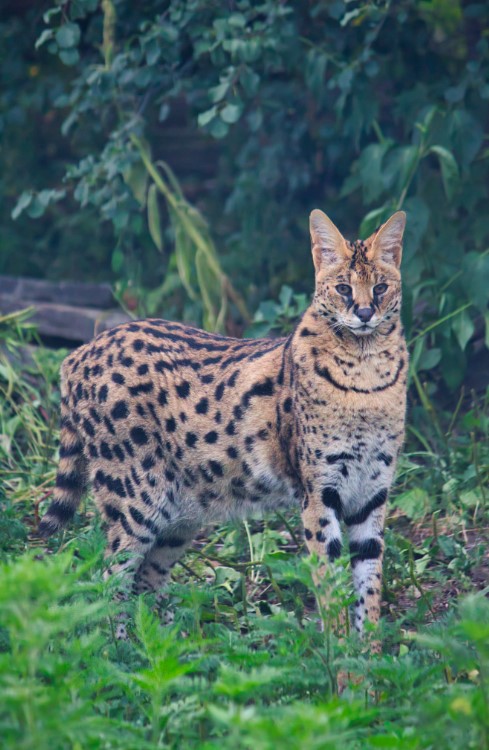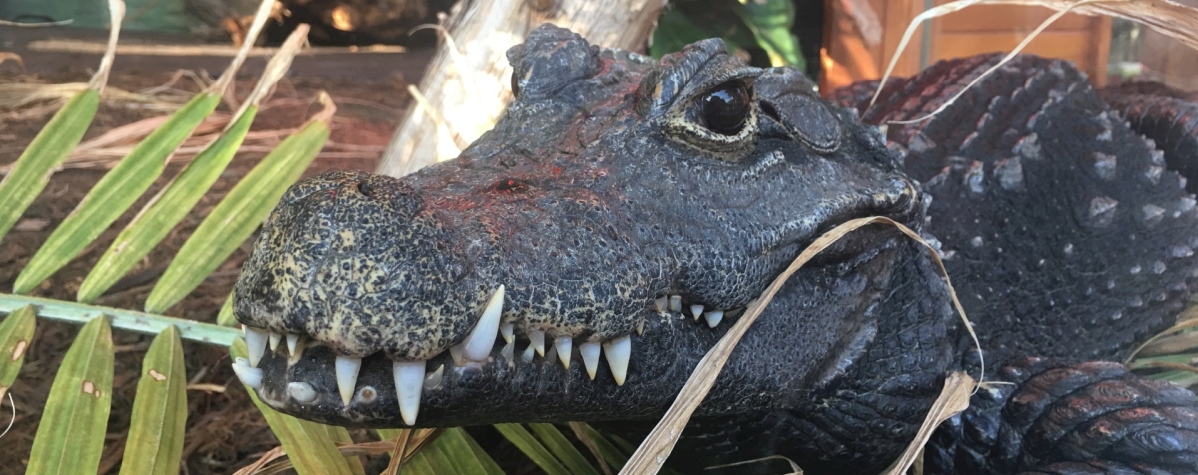Serval
Scientific Classification
| Species |
Leptailurus serval |
| Kingdom | Animalia |
| Phylum | Chordata |
| Class | Mammalia |
| Order | Carnivora |
| Family | Felidae |
| IUCN Status | Least Concern |
Appearance and lifespan
The serval is one of several species of medium-sized African wild cats and weighs 10 to 20 kg (22 to 44 lb). It has a slender body with long legs, a short tail and large oval ears that are positioned closely together on the head. The serval has a long neck and its back legs are longer than its front legs which make it seem very tall.
The serval’s coat is sandy to reddish brown color with bold, dark spots that merge into stripes along the back. The back of the serval’s ears is broadly banded black and white, and this, along with its defining stripes provides the cat with excellent camouflage and allow it to go virtually unseen in tall grasses and brush cover.
The serval’s body is approximately 85 cm in length (33.5”), standing 50 cm tall (19.7”) at the shoulder. The average lifespan of a serval is 12 to 20 years.
Behavior and reproduction
Servals will usually have 1 to 5 kittens, twice a year. They are born mainly in the wet seasons after a gestation period of 70 to 79 days. Kittens are born weighing 227 to 255g (8 to 9oz). The mother will raise her young alone and must leave them often to hunt, leaving them defenseless against predators and making the survival of all the kittens highly unlikely.
When male kittens are old enough to fend for themselves the mother will drive them away. The female young will stay with the mother until they are sexually mature before they are also driven away to establish their own territories. Serval kittens mature at 18-24 months.
The serval is mostly nocturnal and solitary, having a territory of up to 13 km2 (5 mi2). Both male and female servals will mark their territory boundaries by spraying urine continually to ward off other intruding servals.
Ecology and conservation
The serval is found throughout sub-Saharan Africa, but is rarely found in the arid desert region of the Sahara, the western tip of South Africa or areas of the tropical rainforest belt of Central Africa. They exist in wet, savanna, long-grass areas and thrive along riverbanks.
Several regional populations of servals have been designated by different organizations at varying levels of threat. Servals north of the Sahara have been assessed regionally as being Critically Endangered; they are an isolated group with less than 250 mature individuals.
Servals eat a diet of squirrels, hyraxes, snakes, lizards, mole rats, frogs, and insects. It usually only eats fresh meat, but will resort to eating carrion under severe conditions. They can echolocate in the long grasses using their long pointed ears to find food.
Food at the Zoo
At the Park & Zoo the serval’s diet includes a specially formulated feline diet that is provided by the Toronto Zoo, assorted meats, beef bones, pork hock and on occasion, venison.
Threats
The main threat to serval populations is the loss and degradation of wetland and grassland habitat. Also, pelts and skins are still traded in large numbers in some African countries. Hunting is prohibited or regulated in some African countries under the Convention on the International Trade of Endangered Species of Wild Fauna and Flora (CITES).
Did you know?
- The pattern on every serval’s coat is unique to that animal, like a human’s finger prints or a zebra’s stripes.
- Servals have many different vocalizations including snarling, growling, spitting, purring, and a high-pitched cry specifically used for calling other servals.
- Servals are highly crepuscular which means they are active at sunset and sunrise.
Adopt a serval
Become a part of the the Riverview Park and Zoo family through our Adopt an Animal Program!


